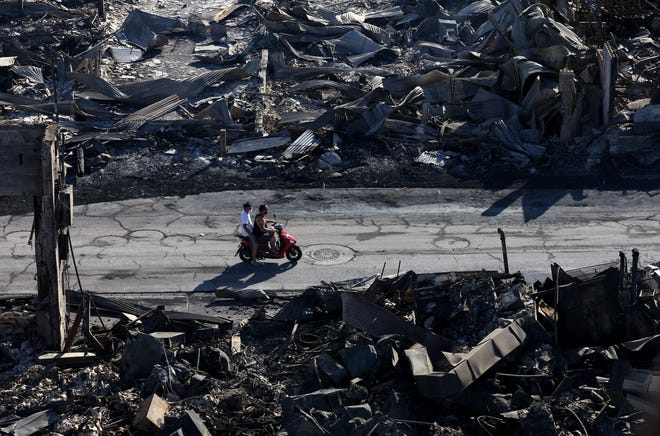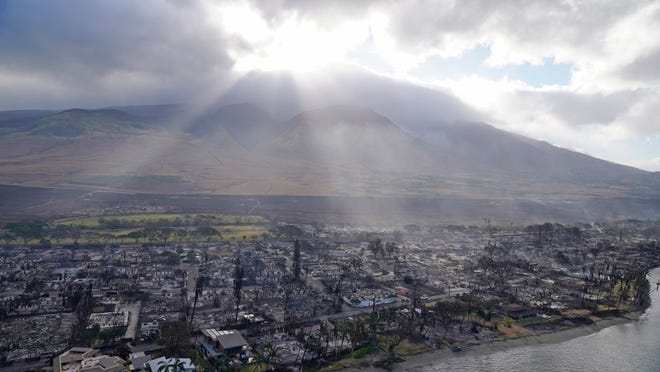
KIHEI, Hawaii − Fire crews battled blazes still burning Saturday from wildfires that ravaged parts of Maui as teams with cadaver dogs combed through the rubble in an intensifying search for the missing.
Firefighters were making progress, but three main wildfires that ignited Tuesday and left 80 people dead and thousands of buildings torched were still not extinguished: The Lahaina fire was 85% contained, the Pulehu/Kihei fire 80%, and the Upcountry Maui fire 50% as of late Friday.
Another fire that prompted evacuations in the Kaanapali area of West Maui on Friday evening was 100% contained within a few hours and evacuation orders were canceled, officials said.
As the sun rose in Kihei on Saturday, the sky was filled with the smell of smoke. On the highway into Lahaina, a historic town decimated by the fires, cars, trucks and buses laden with supplies ignored signs to keep off the median as they tried to bypass the traffic jam ahead of a road blockade.
Residents who were allowed to return to Lahaina on Friday were met with charred remains, demolished homes and businesses and a changed landscape, including the loss of dozens of their neighbors. But police on Saturday were once again restricting access into West Maui, warning people to stay out of the area because of hazards, including toxic particles from smoldering areas.
Hawaii Gov. Josh Green has warned the death toll could climb even higher as the search for the missing continued. Cadaver-sniffing dogs were brought in Friday to assist the search for the dead, Maui County Mayor Richard Bissen Jr. said.

Community members gather supplies for Lahaina
Early Saturday morning, Marina Sanchez, 28, and Dustin Akiona, 31, began loading up their pickup with supplies to make another run into devastated Lahaina Town. There’s a traffic jam leading to a road block on the main road, but they’re hoping to get in “backside.”
The pair spent hundreds on batteries, flashlights, gas, first aid kits and anything else residents have asked for at Lowe’s and Home Depot.
Sanchez said community members have sent her so much money for supplies, she’s asked them to stop. She said money should be going directly to those who have lost their homes and businesses and will need the cash for rent and rebuilding.
“Because our community is so tight, there’s no hesitation,” she said. “I’m really grateful everyone is coming together.”
Sanchez and Akiona have been going house to house, trying to meet individual needs. Some of the homes still standing in Lahaina Town have been converted into makeshift donation centers.
“People know they can go there and get what they need and it’s not limited,” she said. “Such a big part of Hawaii is community.”
Firefighters on the front lines are losing their homes
Firefighters and emergency crews trying to battle the fires and keep people safe in shelters were operating on scant resources themselves, the governor said Friday.
Green said many buildings are so badly damaged in Lahaina and at risk of collapsing that the whole area is a public safety threat. About 30% of the firefighters working this week lost their own homes, Green told Hawaii News Now television.
“They also don’t have cell service or ability to go home,” he said.
Some forms of health care are not available in Lahaina because a clinic and a dialysis center were “incinerated,” Green said.
Deadliest natural disaster in Hawaii in decades
The toll from the wildfires makes this the deadliest natural disaster in the state in decades, surpassing a 1960 tsunami that killed 61 people. An even deadlier tsunami in 1946, prior to Hawaii’s statehood, killed more than 150 on the Big Island, prompting the development of an outdoor siren alarm system.
Overly dry vegetation that acted as fuel, the ongoing drought, strong winds from Hurricane Dora, a high-pressure system and dryness of the atmosphere made for a devastating combination that allowed the flames to spread at a faster pace than firefighters could contain them.
The warning system was notably silent on Maui before residents were forced to run for their lives Tuesday, survivors and officials said. Instead, alerts on cellphones, televisions and radios went out across the island, but widespread power outages and cell signal loss made it unclear how successful that warning was.
“There was no warning. There was absolutely none. Nobody came around. We didn’t see a fire truck or anybody,” said Lynn Robinson, who lost her home in the fire.
‘THERE WAS NOTHING I COULD DO’:As Lahaina burned, he looked for a way out. Then he heard the screams.
A line of abandoned, charred cars paves the path to Lahaina
Blackened, burned cars. Firetrucks abandoned. Boats scorched in the harbor. The path out of Lahaina was a scene of horror in the aftermath of the fires.
Associated Press reporters saw an eerie traffic jam of charred cars that didn’t escape the inferno as surviving roosters meandered through the ashes.
Jesse Kong, resident and owner of a concrete pumping company, described to USA TODAY the horror of fleeing on his bike while seeing others stuck and the highway on fire. One abandoned fire engine still had its lights on. Another was just a smoldering shell.
Kong saw people trapped inside a car fully engulfed by flames; they were screaming. A traffic signal had fallen on the vehicle. He couldn’t get close.
“You can see their flesh burning,” he said. “There was nothing I could do.”
− Ashley Lewis and Jordan Culver, USA TODAY; The Associated Press
Officials warn of ‘toxic’ aftermath of fires
In the wake of wildfires, people returning to inspect the damage of their homes and businesses in Lahaina should be cautious of the “highly toxic” burning areas.
The Hawaii Department of Health said anyone accessing restricted areas should wear a tight-fitting N95 mask, gloves and other protective equipment because inhalation of airborne particles and dust can be a health hazard. The department said people should be careful of ash and ash pits – holes filled with burned ash that can be fallen into and cause burns.
“Ash and dust (particularly from burned buildings) may contain toxic and cancer-causing chemicals including asbestos, arsenic, and lead,” the health department said.
Water, too, wasn’t safe in some places. An unsafe water advisory was put in place Friday in the Upper Kula and Lahaina areas, where some running water had been restored. People should use only bottled water for drinking, brushing teeth and preparing food, Maui County said.
People should limit bathing to quick showers in well-ventilated rooms with lukewarm water, the county said, but Purdue University engineering professor Andrew Whelton told AP even that is not advisable until the water can be tested because there might be “hazardous waste levels of benzene.”
Residents returning to Lahaina face devastation, no water or power
Residents finally allowed back to Lahaina, a treasured town with cultural and religious sites that trace their roots back centuries, discovered a scene of ash-ridden devastation.
“It hit so quick, it was incredible,” Lahaina resident Kyle Scharnhorst told the Associated Press as he surveyed the damage to his apartment complex Friday. “It was like a war zone.”
Only a few items were able to be retrieved from the lot where Summer and Gilles Gerling’s home once stood. They picked up a piggy bank, their daughter’s jade bracelet and watches they gifted each other when they got married. But their wedding rings were lost.
“Safety was the main concern. These are all material things,” Gilles Gerling said.
Anthony Garcia saw dead animals, such as cats and roosters, as he stood under Lahaina’s cherished banyan tree, now charred. As the grim reality sank in, he felt like he had to ground himself and safeguard his mental health.
“If I don’t do something, I’ll go nuts,” said Garcia, who lost everything he owned. “I’m losing my faith in God.”
Residents who could prove they lived in the area or were hotel guests were let back in around noon Friday, according to a county update.
Maui County officials said there would be a daily curfew in place in Lahaina from 10 p.m. to 6 a.m., and certain barricaded areas were off-limits to unauthorized people.
“West Maui remains without power and water, and search crews continue efforts in the Lahaina town area for victims of the brush fire,” the county said.
‘NO PLACE TO LIVE’:Why rebuilding Maui won’t be easy after deadly fires
Hawaii lawmaker: We ‘underestimated the lethality’ of the fire
Days after officials have said the wildfires sparked and spread so quickly there was little time to give any warning, Rep. Jill Tokuda told CNN on Saturday the state “underestimated the lethality, the quickness of fire,” and didn’t plan adequately for redundancies in the emergency alert system.
Though alerts went out to people’s cellphones, Tokuda said there was no cellphone service in many places as the fire began to whip through Maui.
“It’s not like hurricane force winds are unknown to Hawaii, or dry brush, or red flag conditions,” Tokuda said. “We did not learn our lesson” from 2018’s Hurricane Lane, which led to brush fires on Maui and Oahu.
“We have got to make sure that we do better,” Tokuda said.
Hawaii Attorney General Anne Lopez announced Friday a “comprehensive review” of decisions and policies related to the fire would be launched.
Update on the damage, acres burned
The fires that tore through parts of Maui left thousands of buildings damaged or destroyed, and the governor said he anticipates recovery costs to run into the billions and rebuilding could take years.
The Pacific Disaster Center and the Federal Emergency Management Agency late Friday released an update on the devastation caused by the Lahaina fire:
- 2,207 structures damaged or destroyed
- 86% of buildings exposed to the fire were classified as residential
- 2,170 acres burned
- 51,700 square feet of shelter are estimated to be needed
- 4,500 people estimated in need of shelter
- It will cost an estimated $5.52 billion to rebuild
How you can help Maui fire victims
Maj. Gen. Kenneth Hara, from the Hawaii State Department of Defense, asked those who want to donate supplies or volunteer to do so through the Hawaii Emergency Management Agency. James Kunane Tokioka, director of the Department of Business, Economic Development and Tourism, said the governor has also asked people with vacant homes or vacation rentals to provide shelter for those in need.
Several shelters are open to assist those on the islands and several local organizations are collecting donations.
USA TODAY compiled resources for Americans to help people and animals in Hawaii here.
Contributing: Minnah Arshad, USA TODAY; The Associated Press






